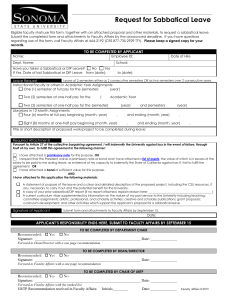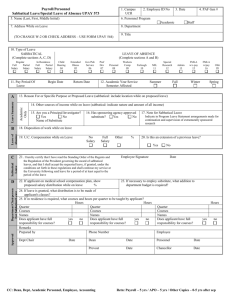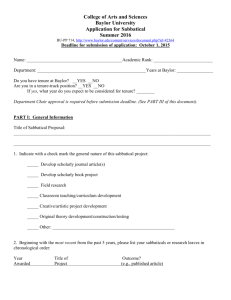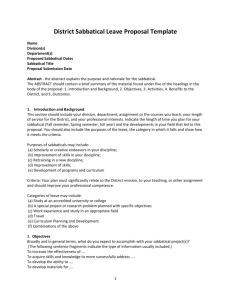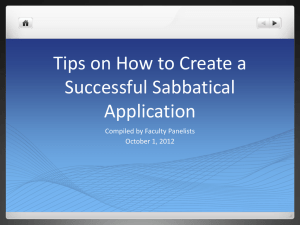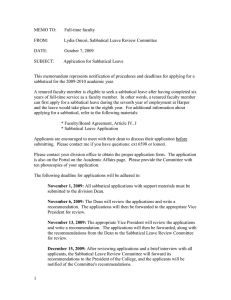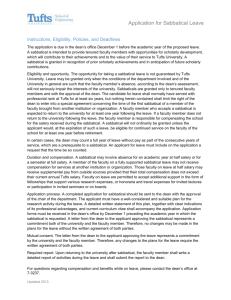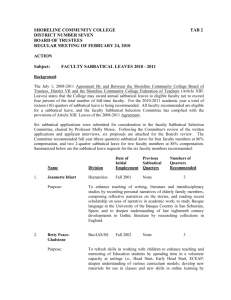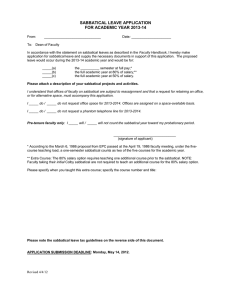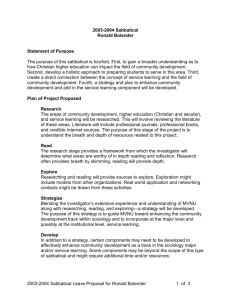What is the difference between Type A, Type B, and Difference
advertisement
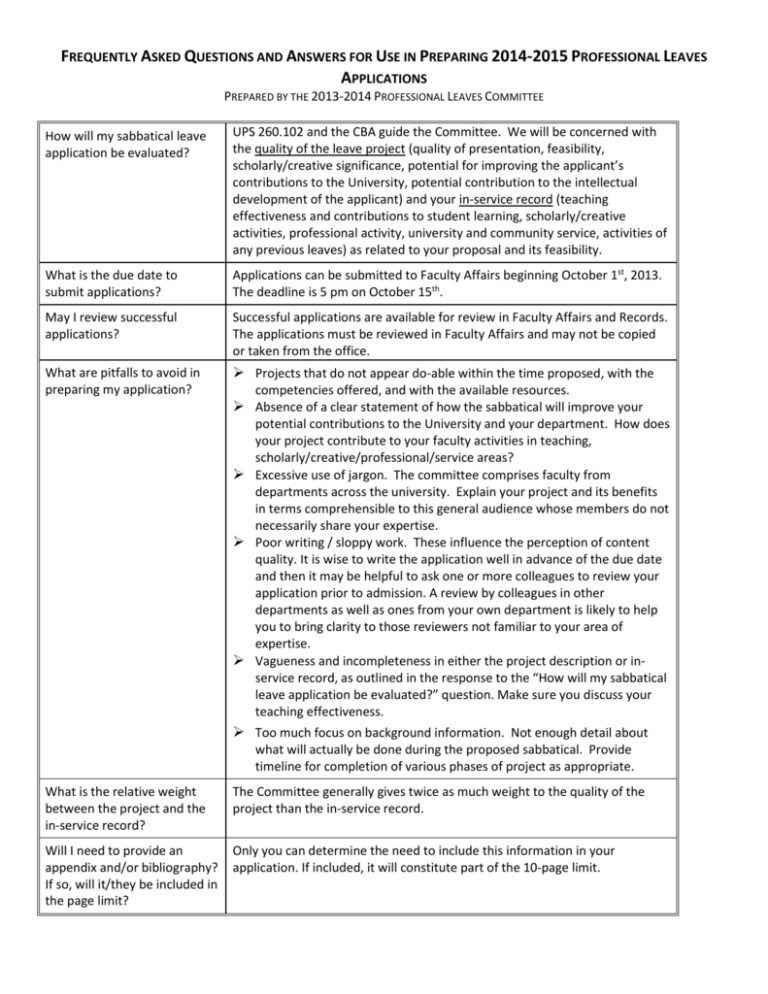
FREQUENTLY ASKED QUESTIONS AND ANSWERS FOR USE IN PREPARING 2014-2015 PROFESSIONAL LEAVES APPLICATIONS PREPARED BY THE 2013-2014 PROFESSIONAL LEAVES COMMITTEE How will my sabbatical leave application be evaluated? UPS 260.102 and the CBA guide the Committee. We will be concerned with the quality of the leave project (quality of presentation, feasibility, scholarly/creative significance, potential for improving the applicant’s contributions to the University, potential contribution to the intellectual development of the applicant) and your in-service record (teaching effectiveness and contributions to student learning, scholarly/creative activities, professional activity, university and community service, activities of any previous leaves) as related to your proposal and its feasibility. What is the due date to submit applications? Applications can be submitted to Faculty Affairs beginning October 1st, 2013. The deadline is 5 pm on October 15th. May I review successful applications? Successful applications are available for review in Faculty Affairs and Records. The applications must be reviewed in Faculty Affairs and may not be copied or taken from the office. What are pitfalls to avoid in preparing my application? Projects that do not appear do-able within the time proposed, with the competencies offered, and with the available resources. Absence of a clear statement of how the sabbatical will improve your potential contributions to the University and your department. How does your project contribute to your faculty activities in teaching, scholarly/creative/professional/service areas? Excessive use of jargon. The committee comprises faculty from departments across the university. Explain your project and its benefits in terms comprehensible to this general audience whose members do not necessarily share your expertise. Poor writing / sloppy work. These influence the perception of content quality. It is wise to write the application well in advance of the due date and then it may be helpful to ask one or more colleagues to review your application prior to admission. A review by colleagues in other departments as well as ones from your own department is likely to help you to bring clarity to those reviewers not familiar to your area of expertise. Vagueness and incompleteness in either the project description or inservice record, as outlined in the response to the “How will my sabbatical leave application be evaluated?” question. Make sure you discuss your teaching effectiveness. Too much focus on background information. Not enough detail about what will actually be done during the proposed sabbatical. Provide timeline for completion of various phases of project as appropriate. What is the relative weight between the project and the in-service record? The Committee generally gives twice as much weight to the quality of the project than the in-service record. Will I need to provide an appendix and/or bibliography? If so, will it/they be included in the page limit? Only you can determine the need to include this information in your application. If included, it will constitute part of the 10-page limit. Page 2 What is the difference between Type A, Type B, and Difference-in-Pay Leaves? Type A are full-salary leaves, lasting one semester for academic year faculty and four months for librarians, 12-month faculty, and 12-month counselors. Type B are one-half-salary leaves, lasting two semesters for academic year faculty and eight months for librarians, 12-month faculty, and 12-month counselors. The salary for a difference-in-pay leave is the difference between the faculty's salary and the minimum salary of the instructor rank. Differencein-Pay leaves are not under the purview of the Professional Leaves Committee; however, faculty considering a Type B sabbatical leave, particularly senior faculty, should investigate the possible advantages of applying for a Difference-in-Pay leave. What are the relevant documents I should review in preparing my application for a professional leave? UPS 260.102 and Article 27 of the Unit 3 CBA provide the timelines, evaluation criteria, review process, and conditions for granting sabbaticals. For Difference-in-Pay leaves, consult UPS 260.104 and Article 28 of the Unit 3 CBA. These documents can be accessed through the Faculty Affairs and Records web page. How many leaves will be granted for 2014-2015? All applications for one-half salary leaves (Type B) will be approved if they meet the criteria set forth in CBA provision 27.5-27.8. Additionally, no fewer than 12% of the total number of campus faculty eligible for a sabbatical [(number will be updated when available) full salary leaves] (Type A) this year shall be granted if a sufficient number of faculty unit employees meet the conditions of Article 27. There were eighty three (83) applications for AY 2013-2014 of which forty three (43) Type A and six (6) Type B leaves were granted. Are some types of projects preferred over others? No. All types of proposals that benefit the professional development of the faculty and CSU Fullerton are acceptable. Is department chair approval needed prior to submitting an application? No. However, your department chair will provide the Administration with a departmental impact statement which will be considered before the Administration makes final approvals. Is there a higher probability of receiving a Type B leave than a Type A leave? The committee does not consider this; it looks only at the quality of the project and the in-service record. What role will the administration play in evaluating the applications? It is difficult for the Committee to speak for the Administration. Certainly, the Administration will have the opportunity to read the applications separately from the Committee. In 2012-2013 AY, the committee recommended sixty one (61) Type A and seven (7) Type B, of which forty five (45) Type A and five (5) Type B leaves were granted. In 2011-2012 AY, the committee recommended forty eight (48) Type A and four (4) Type B, of which thirty nine (39) Type A and four (4) Type B leaves were granted. May I switch from one type of leave to another? Switching is possible in exceptional cases and with appropriate administrative approval. Type A can be switched to Type B, but Type B cannot be switched to Type A. When will I be notified regarding my leave? Last notification was early February. We expect a comparable date next year. Faculty Affairs and Records 9/12/2013
